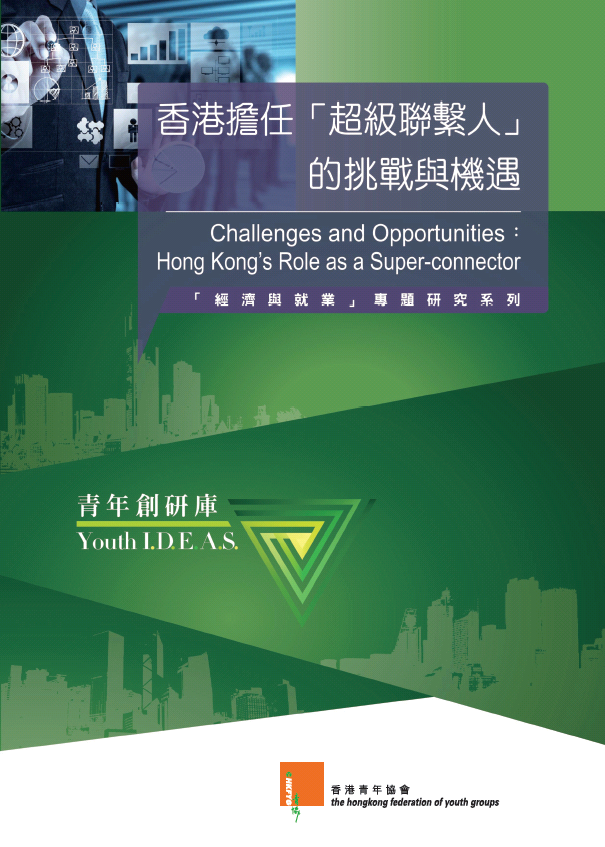Challenges and Opportunities : Hong Kong’s Role as a Super-connector
Youth I.D.E.A.S. 09
Employment and Economic Development
Challenges and Opportunities : Hong Kong’s Role as a Super-connector
30 March, 2016

The Belt and Road Initiative (BRI) refers to the Silk Road Economic Belt and the 21st Century Maritime Silk Road. It is an important long-term foreign development strategy of China. The central government announced the co-operation and development principles of the BRI in 2013 in a bid to achieve connectivity and to seek common prosperity via enhancing co-operation among different countries and regions along the belt and road. The aggregate economic value of these places amounts to US$21 trillion. Covering 4.4 billion people and accounting for more than 60% of the global population[1], they form the longest economic corridors in the world.
Over the years, the economies of Hong Kong and Mainland China have been intertwined. Hong Kong should take into consideration the impact of this interaction when making future economic plans. It should think about how to promote its own economic development by making better use of its excellence in order for both sides to gain mutual benefits during the process of the development of the BRI.
Hong Kong has been playing the role of a “connector” and promoting economic co-operation among different countries and regions. It is a significant gateway for Mainland enterprises to “go global” and bring in foreign enterprises to the Mainland. It is therefore worth looking at how Hong Kong can make effective use of its excellence to connect more countries in the development of the BRI in order to upgrade itself from a connector to a “super-connector”. This issue, which involves the long-term development of both the Mainland and Hong Kong, is highly related to the career prospects of young people.
This study conducts an analysis from the perspectives of system and human resources. On the one hand, it examines the inherent excellence of Hong Kong in successfully connecting the Mainland and overseas countries. On the other hand, it tries to understand the younger generation’s knowledge and perception of the BRI. By synthesizing both perspectives, the study explores how Hong Kong can be prepared to take on the role of super-connector in the development of the BRI.
This study uses an online survey and focus groups to understand young people’s knowledge and perception of the BRI and their willingness to learn about foreign cultures. In addition, experts and scholars are interviewed and asked to give their assessments of (a) the conditions required for Hong Kong to play the role of a super-connector and (b) the merits and inadequacy of Hong Kong. They also give suggestions on the preparations Hong Kong young people can make.
On the basis of the findings of this study, Youth I.D.E.A.S. puts forward four recommendations which focus on consolidating the international status of Hong Kong and strengthening the international perspective of young people.
Discussion
- Hong Kong has a solid foundation to connect the Mainland with foreign countries. It has the competency to develop itself into a super-connector for the BRI if its merits can be further strengthened.
- The biggest challenge in upgrading Hong Kong to become a super-connector is the lack of familiarity with most BRI countries among Hong Kong people.
- The key to becoming a super-connector is to maintain the international status of Hong Kong.
- There are both challenges and opportunities in the development of the BRI. Young people can make use of these opportunities to broaden their horizons and to bring new opportunities for their own personal development.
- Young people generally lack knowledge of and an interest in the BRI. They are not willing to put resources into preparing for it at this stage. If young people could further understand the relationship between them and the BRI, this may increase their choices in terms of future development.
Recommendation
- Strengthening the international perspective of young people
1.1 The government should set up a “Multicultural Exchange Fund” to encourage non-profit making organizations and ethnic minority organizations to organize cultural exchange activities, such as an International Culture Day or a South Asia Food Promotion.1.2 The form of exchange should be enriched and diversified. Exchange activities organized by tertiary colleges and youth service agencies should be extended to include countries and regions in the belt and road. These activities may include student or scholar exchange programmes, internship programmes, and overseas voluntary service programmes. Subsidies could be provided as an incentive.
1.3 Strengthening the international element of educational programmes. Educational institutes should strengthen the international element when designing educational programmes, such as providing knowledge of Islamic commercial law and global geographic politics.
1.4 Providing practical knowledge. Chambers and professional associations in Hong Kong could organize more practical seminars providing information about the life, culture, and career opportunities in the countries along the belt and road.
- Connecting young entrepreneurs. The government should encourage the young people of BRI countries to engage in joint business activities with Hong Kong young people in order to strengthen the multiple business ties of Hong Kong young entrepreneurs.
- Making better use of the existing human network. The government should provide suitable commercial training and employment services to the South Asian and South East Asian young residents of Hong Kong so that they can make better use of their abilities and human networks to connect more countries.
- Continuing school and public education. The media channel and the secondary education Liberal Studies syllabus could be better used to help the younger generation understand the concept of the BRI and its relationship with Hong Kong and young people.
[1] Legislative Council. May, 2015. “One belt one road”. Legislative Council Essentials ISE12/14-15.




